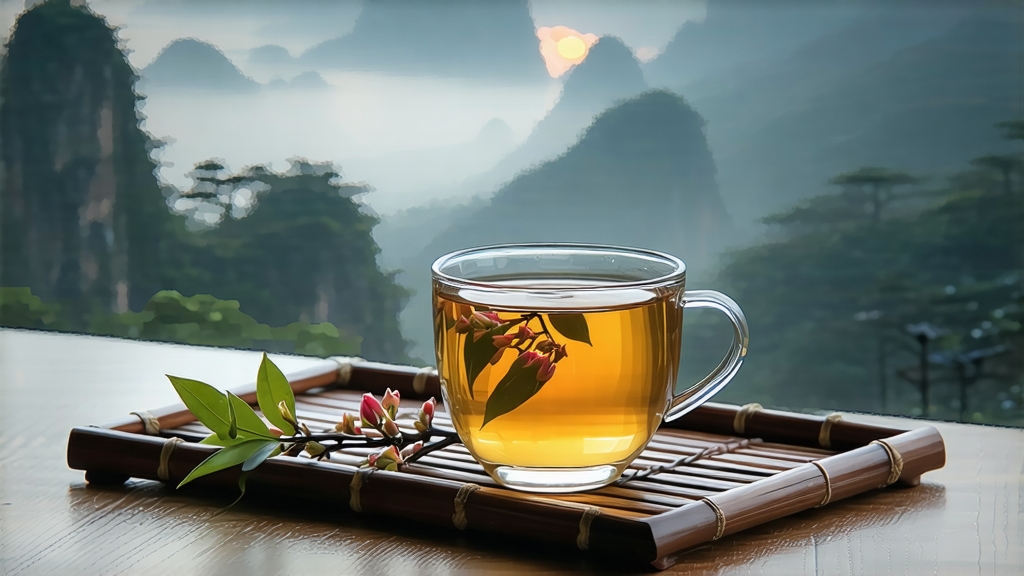
Bai Hao Yin Zhen—literally “White Hair Silver Needle”—is the most aristocratic expression of China’s white-tea family. To the uninitiated it may look like a small pile of pale twigs, but in the fingers of a practiced tea master each slim bud is a silvery arrow packed with centuries of terroir, craft, and quiet ceremony. This essay invites the international reader to follow that arrow backward through time, into the cool March air of northern Fujian, and forward again into the steam of a gaiwan where the leaf re-enacts its own creation myth.
-
Historical echoes
White tea as a named category appears in Song-dynasty treatises, yet the primacy of buds-only plucking is first credited to the Qing-era tea merchants of Taimu Mountain near Fuding. Seeking a tribute tea that could travel from subtropical port to imperial Beijing without losing freshness, they discovered that the youngest buds, allowed to wither rather than to be panned or rolled, retained a luminous fragrance and a surprising resistance to mold. By the late nineteenth century Silver Needle was already commanding higher prices in Hong Kong than most Wuyi rock oolongs, and in 1915 it won a gold medal at the Panama-Pacific International Exposition, securing its global reputation. Today the European Union protects “Fuding Bai Hao Yin Zhen” as a geographical indication, placing it legally alongside Champagne or Parma ham. -
Terroir and micro-seasonality
Authentic Silver Needle is produced in only two micro-zones: the granite foothills of Taimu Mountain in Fuding County and the red-clay plateaus of Zhenghe County, both within Fujian’s Ningde prefecture. The cultivars are strictly Da Bai Hao (“Big White Hair”) and, in smaller lots, the heirloom Xiao Bai (“Small White”). Spring begins earlier on the eastern slopes facing the East China Sea; buds can be plucked from mid-March, when nightly temperatures still drop to 8 °C, slowing enzymatic activity and concentrating amino acids. A single mu (0.067 hectare) of mature bushes yields barely one kilogram of finished buds, making the harvest window—often only five to seven days—the most anxiously watched period in the local agricultural calendar. -
Plucking etiquette
The rule is merciless: one bud, no leaf, no stem, no damage. Experienced pickers use the thumb and middle finger to snap the bud downward, never upward, so the tender base remains sealed. Baskets are shallow bamboo trays lined with hemp cloth; buds must not be pressed deeper than 5 cm to avoid bruising. The pluckers work in silence, believing that conversation distracts the concentration required to feel the exact moment of detachment. By 9 a.m. the sun is too strong, ending the harvest for the day. -
The craft of withering
Unlike green tea, Silver Needle is never heated to “kill-green.” Instead, the buds undergo a 36- to 48-hour dual withering that is half nature, half choreography. First comes sun-withering: trays of buds are placed on raised bamboo racks angled 15° to the south-east, allowing morning light to evaporate surface moisture for no more than twenty minutes. The moment the bud tips feel warm to the back of the hand, trays are whisked into the shade of a ventilated barn where ambient humidity hovers at 65%. Here the buds rest on reed mats, turned every hour through the night so that moisture migrates outward evenly. Masters judge readiness not by clock but by touch: a perfectly withered bud bends without snapping, and the tiny leaf scale inside the needle unfurls like a yawn when stroked. Final moisture is reduced to 8–9%, yet enzymatic oxidation is arrested at roughly 5–7%, giving white tea its signature pale liquor and understated character. -
Grading and aging paradox
Silver Needle is classified into two grades—Supreme and Standard—based on bud length (Supreme must exceed 2.5 cm) and the percentage of intact tips. Curiously, the same tea that commands astronomical prices when fresh also appreciates in value when carefully aged. In 2015 a 1997 Fuding cake of compressed Silver Needle sold at auction in Guangzhou for USD 8,600 per kilogram. Aging transforms the amino-acid profile: L-theanine diminishes while theaflavins and microbial aromatic esters increase, yielding a